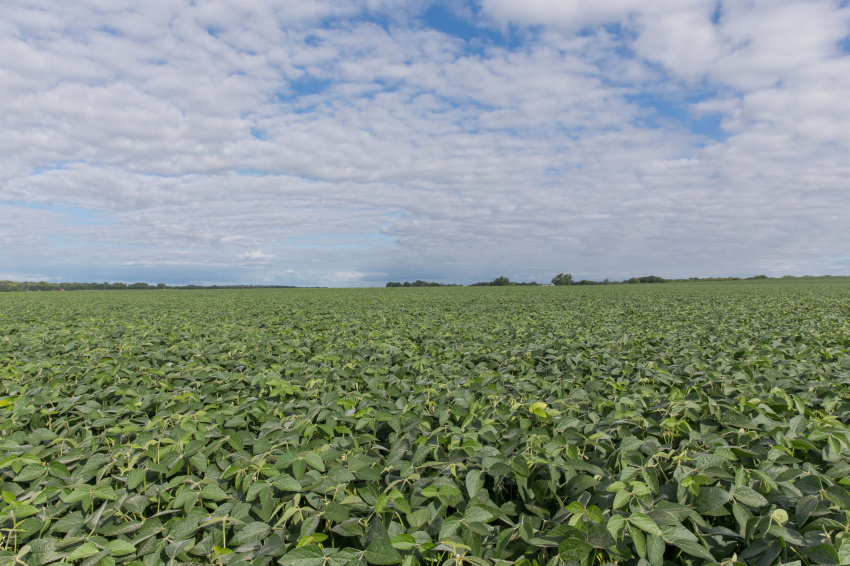Growing Crops and Profits with High Oleic

Along with rain showers, longer days and warmer temperatures, spring brings sprawling fields of soybean seedlings sprouting above ground and reaching for springtime sunshine. Those seedlings will use that sunlight to create complete protein feed for animals. And if they’re high oleic soybean varieties, they’re producing oil with increased functionality and extra farmer profit, too.
High oleic soybeans are a prime example of your soy checkoff working for you. They’re a product of decades of careful research to meet the end-user demand for better oil and have since been used in many applications. High oleic soybean oil makes an excellent frying oil and shortening for food companies, for example.
Kevin Wilson, soy checkoff farmer-leader from Indiana, plans on planting high oleic soybeans this year, marking his seventh season with these innovative beans in his fields.
“When high oleic was first introduced, it happened to be available through the facility in Frankfort, and that location is only about 40 miles from where I’m at,” Wilson said. “We store and always have stored a few of our soybeans every year, so high oleic matched up to our current program pretty well. Plus, you get a premium on top of it.”
Wilson said he wasn’t without his reservations for the first few years. He monitored his yields closely to ensure high oleic beans didn’t lag behind his commodity beans.
“Even though you’re getting a premium, if you’re getting a yield drag, then that could wipe out part of the premium,” said Wilson, whose fears were put to rest within the first few seasons.
“The first year didn’t raise any concerns and then the second year didn’t again, and so by the third year, we had gained pretty good confidence that we would be in good shape growing high oleic,” he added.
Growing Value and Innovation
High oleic soybeans increase U.S. soy’s global competitiveness by setting it apart from other vegetable oils and soy grown in other countries. Having high oleic soybean oil on the market increases the average value of all soybean oil, which helps to increase long-term demand for U.S. soybean farmers.
Because high oleic soybeans produce an improved oil for some key customers in the food industry and industrial sectors, the soy checkoff has invested in bringing the varieties to more farmers and in showing customers the benefits of high oleic soybean oil. This product not only helps U.S. soybean farmers win a bigger share of the food oil market but also opens doors for new sustainable industrial uses that commodity soybean oil isn’t suited to provide.
Going into his eighth year as a soy checkoff farmer-leader, Wilson has seen firsthand the high oleic program grow not only profit on his farm, but also demand for his soybeans and his fellow farmers’ crop.
“There continues to be plenty of soybean oil to go around, so the checkoff’s work to help out on the oil side is a big plus for soybean farmers,” Wilson said. “And with high oleic, we’re gaining some value back not only from the increase in price but from the fact that we’re gaining more and more demand for our product.”
Wilson also grows corn, processing tomatoes and hay on his farm, along with managing a small cow-calf herd. Each year, as he planned his next crop season, Wilson couldn’t help but add more acres of high oleic soybeans — until he recently reached his storage capacity.
“It gives us more income because we’re getting a higher price,” said Wilson. “But, it also helps cover our storage costs in the long run.”
On top of being a profit generator for Wilson and his farm, high oleic soybeans are not much different than growing commodity soybeans. They planted, grew, harvested and yielded the same as commodity soybeans — they just required a little extra machinery cleaning and storing them separately.
Wilson said a one-time cleanup of his planter before planting high oleic and then a quick sweep of the combine adds up to a better paycheck with not a lot of extra steps. All thanks to the checkoff.
“I want to give credit to my fellow soy checkoff directors who are farming in areas where high oleic isn’t available yet,” Wilson said. “For them to still think that high oleic had potential, it took a lot of foresight in a lot of their eyes to make sure we kept investing in this program.”
Thinking Ahead with High Oleic
As spring approaches and farmers make their seed decisions for this year’s planting, Wilson realizes that changing up your planting program can be intimidating but encourages farmers to give high oleic a chance. He suggests starting by planting one farm or a few fields and seeing how it fits into your program.
“If it’s something in a grower’s area that is maybe a potential to work with, I would encourage farmers to do a few acres and give it a shot,” said Wilson.
For more information on high oleic and to find out if the varieties are available near you, visit soyinnovation.com.



